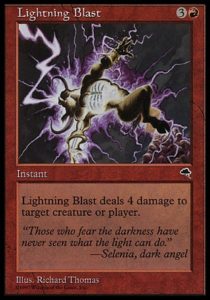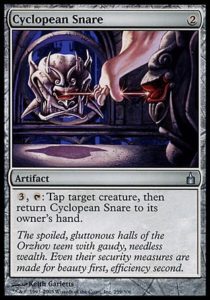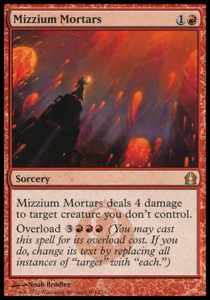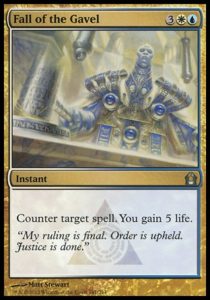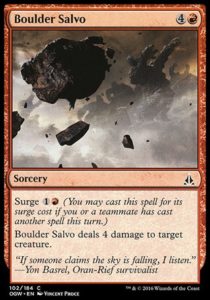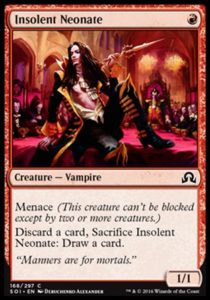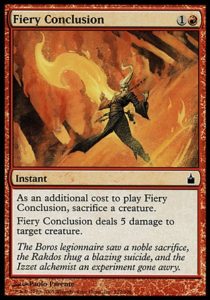Removal design is one of the most fascinating parts of Magic. As discussed last week, the quality of any given Limited format is deeply intertwined with what removal spells are available at common.
A careful balance needs be maintained: if [casthaven]Lightning Bolt[/casthaven] and [casthaven]Doom Blade[/casthaven] are common (as they were in Magic 2010 and 2011), then the format contorts to accommodate the diminished value of creatures (which are generally the lifeblood of interactive Magic). If the best common removal spells are [casthaven]Death Wind[/casthaven] and [casthaven]Mist Raven[/casthaven] (as was the case in Avacyn Restored), players have little means of interacting with each other aside from turning their creatures sideways, every turn, until someone loses. Neither form of format is particularly satisfying for long. Limited works best when removal is high-volume, and medium- to low-powered.
This week, rather than look at Limited removal as a whole, we’ll look a single card. And unlike last time, when we checked out [casthaven]Tar Snare[/casthaven], we’ll be analyzing one of the best common removal spells in Eldritch Moon: [casthaven]Alchemist’s Greeting[/casthaven].
[casthaven]Alchemist’s Greeting[/casthaven] seems a very simple removal spell. It’s a burn spell that doesn’t go to the face and which has a major set mechanic, Madness. However, it’s far from the first spell to do four damage. Let’s see what came before and how it compares:
Precedent
Many, many spells in Magic do four damage to a creature. There’s the classic [casthaven]Lightning Blast[/casthaven] and [casthaven]Psionic Blast[/casthaven]/[casthaven]Char[/casthaven]. One of the greatest red creatures in Limited is also one of the greatest four damage spells ever printed: the venerable [casthaven]Flametongue Kavu[/casthaven]. [casthaven]Alchemist’s Greeting[/casthaven] compares unfavorably to [casthaven]Flame Slash[/casthaven] and the more recent [casthaven]Bathe in Dragonfire[/casthaven] (a card which demonstrates just how powerful [casthaven]Flame Slash[/casthaven] is).
A brief aside: To see how powerful [casthaven]Flametongue Kavu[/casthaven] is, consider [casthaven]Somberwald Stag[/casthaven]. The stag costs an additional colored mana and is only adept at killing creatures with two or fewer toughness (granted, it also is better on an empty board and has an extra point of toughness, neither of which counterbalance it costing five mana). It’s substantially worse than [casthaven]Flametongue Kavu[/casthaven], yet it’s one of the strongest uncommons in Eldritch Moon. THAT is how insanely good [casthaven]Flametongue Kavu[/casthaven] is.
[casthaven]Alchemist’s Greeting[/casthaven], in addition to following in the footsteps of plenty of four damage burn spells, also follows the tradition of burn spells utilizing a set mechanic. These notably include “[casthaven]Shock[/casthaven] Plus” cards like [casthaven]Galvanic Blast[/casthaven] and [casthaven]Burst Lightning[/casthaven] (where the set mechanic transforms them from [casthaven]Shock[/casthaven] into [casthaven]Lightning Blast[/casthaven]). [casthaven]Alchemist’s Greeting[/casthaven] benefits from the set’s mechanic just as Oath of the Gatewatch’s [casthaven]Boulder Salvo[/casthaven] and Shadows Over Innistrad’s [casthaven]Fiery Temper[/casthaven] (a reprint from both Time Spiral and Torment) do, by having its cost reduced.
In short, [casthaven]Alchemist’s Greeting[/casthaven] looks a whole lot like many spells which have come before.
Power, Efficiency, and Flexibility
How good a removal spell is comes down to a combination of its power (the range of creatures it’s able to kill), efficiency (mana cost), and flexibility (how easy it is to use).
Power: [casthaven]Lightning Bolt[/casthaven], [casthaven]Incinerate[/casthaven], and [casthaven]Incendiary Flow[/casthaven] have identical power: they are all able to kill the exact same range of creatures (setting aside weird things, like [casthaven]Devoted Caretaker[/casthaven]). By this definition, [casthaven]Alchemist’s Greeting[/casthaven] is more powerful than [casthaven]Lightning Bolt[/casthaven], since it can kill a wider range of creatures. [casthaven]Alchemist’s Greeting[/casthaven] is worse than but comparable to a card like [casthaven]Doom Blade[/casthaven], since four damage is generally sufficient to kill the majority of creatures.
Efficiency: [casthaven]Lightning Bolt[/casthaven] is the master of efficiency, dealing 3 damage per point of mana ([casthaven]Flame Slash[/casthaven] is even more efficient, dealing 4 damage/mana). [casthaven]Incinerate[/casthaven] and [casthaven]Incendiary Flow[/casthaven] are half as efficient, dealing 1.5 damage per point of mana. [casthaven]Alchemist’s Greeting[/casthaven] has two different efficiencies: cast normally, it deals 0.8 damage per point of mana (4 damage divided by 5 mana), which isn’t great. Cast for madness, it deals 2 damage per point of mana, which is pretty darned good (as efficient as [casthaven]Shock[/casthaven] and 33% more efficient than [casthaven]Bathe in Dragonfire[/casthaven] and [casthaven]Incendiary Flow[/casthaven]. So, depending on the mode it’s cast, [casthaven]Alchemist’s Greeting[/casthaven] is either quite inefficient, or quite efficient.
Flexibility: [casthaven]Lightning Bolt[/casthaven] is incredibly flexible. It is instant speed, can target creatures or players, and has no restrictions (unlike the equally powerful and efficient [casthaven]Shard Volley[/casthaven]). [casthaven]Alchemist’s Greeting[/casthaven], on the other hand, is sorcery speed, can only target creatures, and is only efficient if one has the means to discard it.
Overall: [casthaven]Alchemist’s Greeting[/casthaven] is a high power and inflexible removal spell of variable efficiency (either high or low). It’s certainly worse than cards like [casthaven]Lightning Bolt[/casthaven] and [casthaven]Flame Slash[/casthaven], both cards which are almost always too powerful removal spells to be common.
This past weekend, many of us witnessed that [casthaven]Alchemist’s Greeting[/casthaven] is a solid removal spell. That’s hardly surprising—it strongly resembles other contemporary, top tier common kill spells. However, that says little about the design of the card.
The Verdict
[casthaven]Alchemist’s Greeting[/casthaven] is an excellently designed Magic cards. We already know that it’s got the right power level (the mix of power, efficiency, and flexibility), which is critical for keeping Limited balanced and fun. However, it’s much more than the sum of its parts. To demonstrate this, let’s compare it to an extremely similar card, [casthaven]Boulder Salvo[/casthaven].
Ease of Use: [casthaven]Boulder Salvo[/casthaven]’s hoop is a lot easier to jump through than [casthaven]Alchemist’s Greeting[/casthaven]’s: all you need to do is put some cheap spells in your deck, something which basically all decks want, anyway. That’s strong design, since it rewards players for doing things they already want to do (play spells). [casthaven]Alchemist’s Greeting[/casthaven] requires players to do something unintuitive (discard cards), which is harder for newer players to understand and mandates that players find discard outlets.
In short, [casthaven]Alchemist’s Greeting[/casthaven] is much harder to use than [casthaven]Boulder Salvo[/casthaven].
Affect on Deckbuilding and Drafting: [casthaven]Boulder Salvo[/casthaven] mildly contorts deckbuilding by making one prioritize cheap spells like [casthaven]Expedite[/casthaven] and [casthaven]Slip Through Space[/casthaven]. However, it doesn’t need those spells to function (practically all Limited decks need to have two drops these days), and so all red decks use it and prioritize it highly. It was the best common red spell in Oath of the Gatewatdh.
[casthaven]Alchemist’s Greeting[/casthaven] more strongly contorts deckbuilding, since it’s worse than [casthaven]Throttle[/casthaven] (a medium-to-low powered removal spell, particularly in SoI Limited) if you can’t cast it for its madness cost. If you can’t jump through its hoop, perhaps you’d rather draft a [casthaven]Certain Death[/casthaven] or even a solid creature like [casthaven]Brazen Wolves[/casthaven].
Because [casthaven]Alchemist’s Greeting[/casthaven] is harder to use than [casthaven]Boulder Salvo[/casthaven], it isn’t the de facto best kill spell and isn’t one that all decks will prioritize similarly. This makes for more dynamic pick orders, where players in the same colors value cards differently. [casthaven]Lightning Bolt[/casthaven] isn’t an interesting draft pick, because it’s almost always better than every other card in the pack. [casthaven]Boulder Salvo[/casthaven] isn’t that interesting, either, since it’s almost certainly better than every other red common in any given pack. [casthaven]Alchemist’s Greeting[/casthaven] is an interesting pick because all red drafters will value it differently.
In short, [casthaven]Alchemist’s Greeting[/casthaven] has a bigger effect on deckbuilding and drafting than does [casthaven]Boulder Salvo[/casthaven] (because it’s harder to use), and that’s a good thing (in this particular case).
Payoff: Surge/Madness both create a three mana discount (which is a great payoff). However, Madness allows [casthaven]Alchemist’s Greeting[/casthaven] to be cast at instant speed. This is a dramatic increase in flexibility (and one which comes from engaging with the card’s inflexibility); [casthaven]Alchemist’s Greeting[/casthaven] has a higher potential payoff to match its higher deckbuilding cost. Moreover, this non-obvious boon is an excellent example of what Mark Rosewater calls lenticular design; the inexperienced player understands how the card works and wants to be used, while the experienced player sees the additional potential hidden in plain sight. The card means different things to different people, not only in terms of dynamic pick orders, but in terms of how experienced the player is.
That’s a whole lot of play to pack into basically nine words of text (if you discount Madness’ reminder text, which is the point of having keywords).
Thank you so much for checking out this installment of Drawing Live. Hopefully, it’s helped some folks understand a bit more of the intricate design work that goes into seemingly-simple common removal spells like [casthaven]Alchemist’s Greeting[/casthaven] and [casthaven]Tar Snare[/casthaven]. Every card in Magic has such a story, from the obvious [casthaven]Archangel Avacyn[/casthaven] to the easily missed [casthaven]Chaplain’s Blessing[/casthaven] (which is quietly one of the most efficient lifegain spells in Magic).
And, as always, thanks for reading.
—Zachary Barash
Zachary Barash is a New York-based game designer. Playing since 1994, he loves Limited and drafts every available format (including several that aren’t entirely meant to be drafted). His favorite contemporary Magic design is [casthaven]Explore[/casthaven], because it’s a [casthaven]Time Walk[/casthaven] cast for minimal value.



